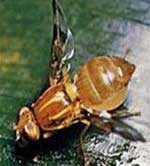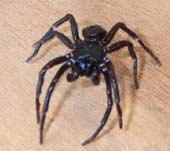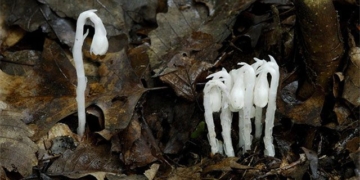In nature, small animal species often do not live long. The reason is simple: they are always at risk of becoming a snack for other animals.
Evolution understands this, so the best way to ensure these creatures survive is to encourage them to mature quickly and reproduce as much as possible. That’s why every summer, you will hear the buzzing of cicadas everywhere.
Cicadas typically grow and age very quickly; their lifespan is measured in days, weeks, and at most, months. During the mating season, they have one sole objective: to attract mates and then lay as many eggs as possible.
Each summer, a single cicada can lay hundreds of eggs. This is in stark contrast to larger animals like elephants and humans. When size and intelligence confer survival advantages, larger animals only need to give birth to a few offspring in their lifetime.
Thus, they do not rush to mature. Having fewer offspring and a longer lifespan to protect and nurture their young is the strategy of larger animals, which is why they also have longer lifespans, often reaching several decades.

Each summer, a cicada can lay hundreds of eggs
Looking at this pattern, we can clearly see a common contrast in the animal kingdom. If a species does not live long, it will reproduce prolifically; conversely, if it does not reproduce much, it will live longer.
Animals generally cannot maximize both processes since reproduction and maintaining longevity are energy-consuming biological activities. The paradox only occurs on a small scale; for example, in every insect colony such as bees, termites, and ants, you will always find queens that both reproduce abundantly and live very long.
For instance, many queen bees lay hundreds of eggs daily, yet they can live for decades, while female worker bees that do not lay eggs die after a few months. Similarly, queen termites can live up to 20 years and reproduce continuously, while sterile worker termites have short lifespans.
So what allows queen bees, queen ants, and queen termites to escape the natural laws of reproduction and aging?
Searching for the secret to abundant reproduction and longevity
A few years ago, a group of international biologists began to delve into the mysteries of these insect species. They realized that even DNA sequences could not explain the unusual youthfulness and longevity of queen bees compared to worker bees.
All worker bees are born as daughters of the queen. One of them will later be selected to become the next queen, so genetically, they are not different from each other.
Scientists believe there must be a selective pressure that helps queens live longer than worker bees. As the only egg-laying member of the colony, the maintenance of population size and colony scale rests entirely on the queen. She is the one who produces worker bees, drones, and future queens.
Therefore, there must be an evolutionary mechanism that allows them to both reproduce abundantly and live long. But what is that mechanism? By studying the fruit fly species, scientists have uncovered some clues.

The choice between reproducing abundantly or living long in this fly species is a switch caught at a branching circuit.
Specifically, they found that Drosophila melanogaster flies could significantly extend their lifespan if frequently starved. However, in return, these flies would lay fewer eggs.
Thus, the choice between reproducing abundantly or living long in this fly species is a switch caught at a branching circuit. When one branch of the switch is turned on, the other branch must be turned off.
From this research, scientists also discovered a network of genes capable of sensing the presence of nutrients. These genes are activated by the concentration of amino acids and carbohydrates in the diet.
When food is scarce, they know to send signals to slow down the reproductive process while simultaneously increasing the animal’s longevity by investing energy into tissue repair processes.
The goal is to maintain the animal’s lifespan until a day when food resources become abundant again, at which point they can reproduce once more. In some experiments, scientists have been able to extend the lifespan of these flies by turning off their nutrient-sensing genes.
If the scientists’ hypothesis is correct, the rate of aging in insects is not a constant. It can be a variable depending on the environment and how the insect species maximize the resources they have. When resources are abundant, insects will activate their reproductive season. When resources are limited, they enter a maintenance mechanism to live longer.
What happens when scientists force worker bees to lay eggs?
We know that worker bees are female bees in the colony, but they have sacrificed their natural egg-laying ability to perform nursing duties. Worker bees can dedicate their entire lives just to caring for the queen and her offspring, who must refer to them as aunts or grand-aunts.
However, a strange effect occurs: when you remove the queen from the hive, the worker bees will reactivate their dormant ovaries. At this point, worker bees can also lay eggs.
This does not necessarily turn worker bees into queens, but experiments have shown that worker bees that lay eggs also gain some special abilities that are typically reserved for queens.

For example, in a study published in 2021, researchers at the University of North Carolina Greensboro discovered that egg-laying worker bees had a very high resistance to a dangerous virus strain.
They also exhibited resistance to paraquat, a herbicide that can destroy proteins, DNA, and other cellular components. Such damage also occurs during the aging process of insect bodies like bees, but is caused by waste products from metabolic processes.
Expanding the research to ants and termites, scientists discovered several genes that play crucial roles in reproduction, and these genes operate differently in the bodies of queens compared to sterile individuals.
Some genes carry instructions to produce a protein called vitellogenin, which is present in queens across all insect species from bees to termites to ants. The primary role of vitellogenin is to support the production of egg yolk. However, some scientists suspect that this protein may also have additional functions.
At least in honeybees, experiments have shown that vitellogenin acts as an antioxidant. If vitellogenin has similar effects in other social insect species, it could contribute to the anti-aging capabilities of queens in these species.
Different underlying strategies among species
Judith Korb, an evolutionary biologist at the University of Freiburg in Germany, stated that apart from common factors like vitellogenin, different social insect species also have varying strategies for anti-aging and longevity for their queens.
For example, Korb is studying a termite species called Cryptotermes secundus, also known as the drywood termite. They are characterized by never leaving their nest, only boring holes and making homes in dead tree trunks. These termites consume decaying wood inside, so worker termites do not have to struggle to find food.
As a result, they can freely develop, even maintaining their reproductive capabilities to prepare to invade other tree trunks and establish a new colony of their own. At this point, the worker termite can become a queen.

Cryptotermes secundus termites never leave their nest, only boring holes and making homes in dead tree trunks.
In the process of studying the Cryptotermes secundus species, Korb and colleagues discovered that when young, non-reproductive worker termites, the genes related to their anti-aging processes were more active. But as they aged and matured reproductively, the activity of those genes decreased: the focus now shifted primarily to reproduction.
In this species, worker termites can live for a few years, while queens can survive a decade or longer. This clearly demonstrates a significant disparity between the lifespans of Cryptotermes secundus worker termites and queens in the colony.
However, Cryptotermes secundus worker termites still live much longer than worker termites from other species. For instance, the queen of Macrotermes bellicosus can live over 20 years, but the workers of this species only survive for a few months. The issue is that Macrotermes bellicosus workers cannot reproduce, and they face a life of sterility throughout their short existence.
Korb noted that the origins of these disparities stem from a group of genes that prevent damage from oxidation, or genes that allow queens to repair damage within their bodies.
However, each species has genes that operate in different ways. Scientists have also examined the nutrient-sensing gene networks that help fruit flies increase their lifespan, but they did not find that their activity patterns were similar to those of termites.
Nonetheless, a new discovery indicates that there are differences in the activity of genes related to the production of juvenile hormones, a molecule involved in reorganizing the bodies of most adult insect species.
Scientists speculate that perhaps the same type of hormone that allows adult insects to mature may also help them delay the aging process. Yet again, the specific genes related to these juvenile hormones are regulated differently across insect species.

The balance between lifespan and reproduction in these species is much more flexible than we previously thought.
For Korb, this diversity reflects an essential aspect of the aging process: there is no single button or switch that allows all social insect species to choose whether to age slowly, live long, or reproduce abundantly.
Instead, the balance between lifespan and reproduction in these species is much more flexible than we once believed. Each species has a different solution, depending on their natural and social environments.
Therefore, no single organism can teach humans everything. We must learn from them bit by bit if we wish to seek our own rejuvenation and longevity remedies.





















































